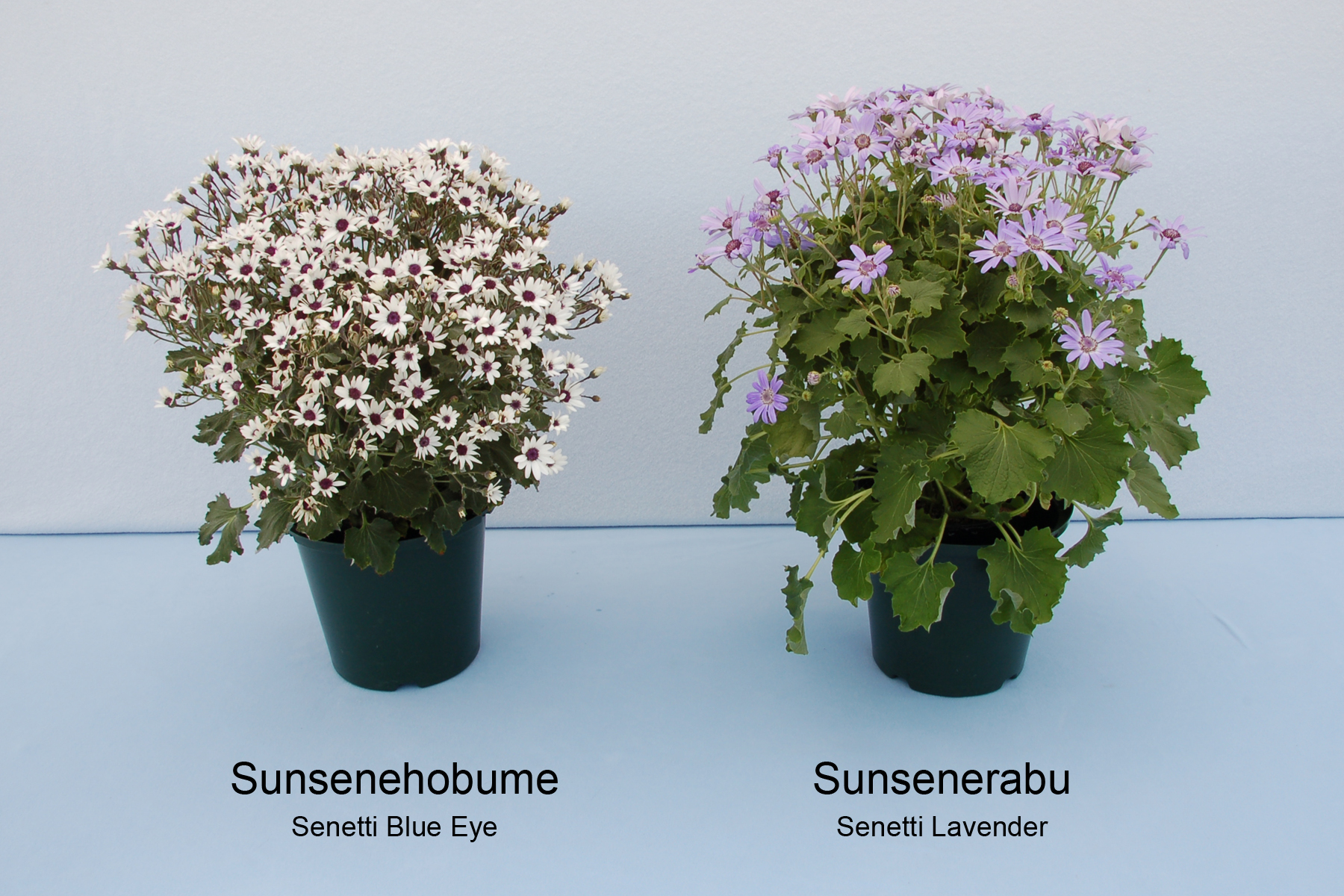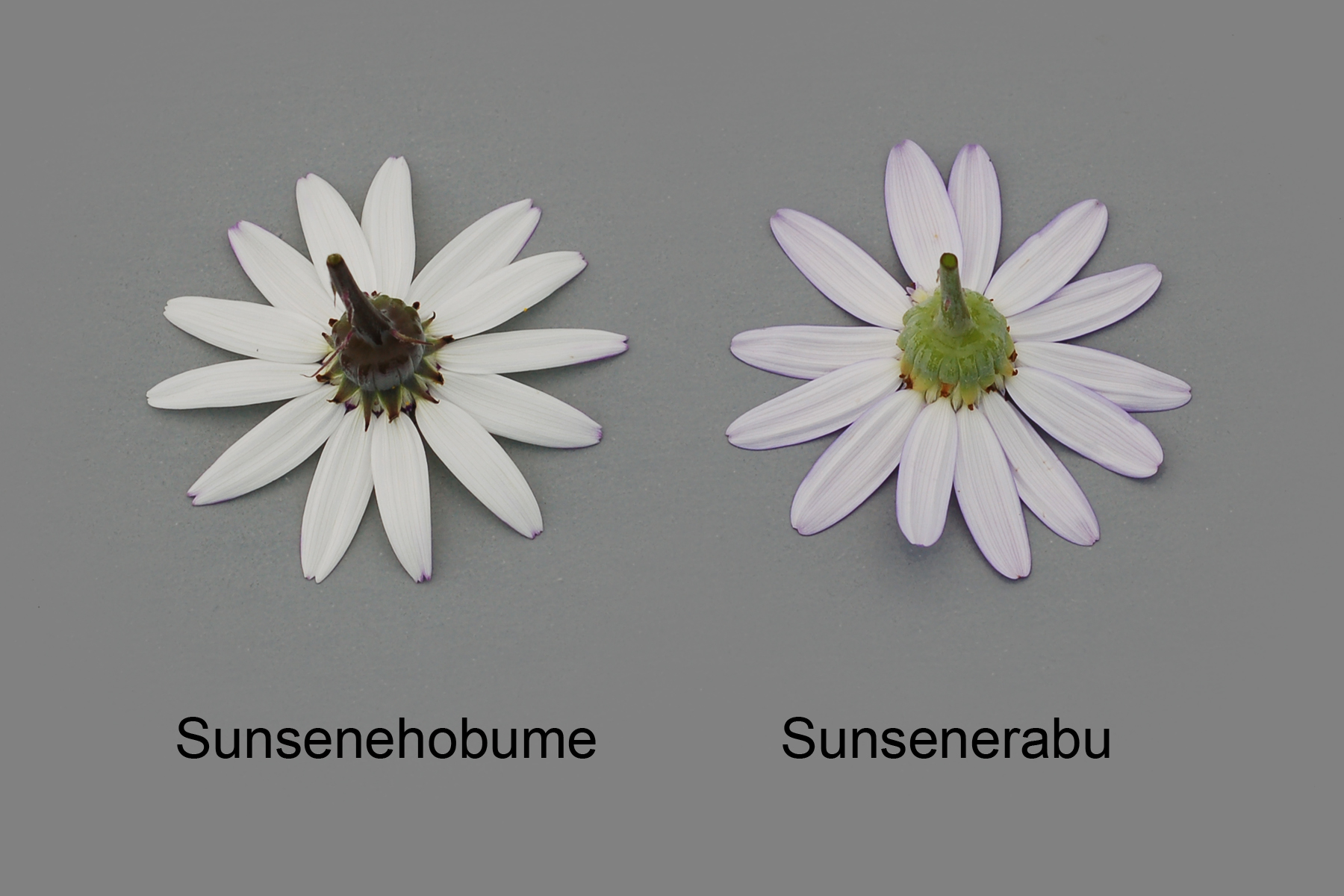Sunsenehobume
| Denomination: | 'Sunsenehobume' |
|---|---|
| Trade name: | Senetti Blue Eye |
| Botanical Name: | Pericallis cruenta |
| Applicant/Holder: |
Suntory Flowers Limited Administrative Division 4-17-5 Shiba, Minato-ku Tokyo 108-0014 Japan |
| Breeder: |
Tomoya Misato, Yamanashi, Japan |
| Agent in Canada: |
BioFlora Inc. 38723 Fingal Line R.R. #1 St. Thomas, Ontario N5P 3S5 Canada Tel: 519-317-7511 |
| Application Date: | 2014-02-03 |
| Application Number: | 14-8198 |
| Grant of Rights Date: | 2017-10-23 |
| Certificate Number: | 5562 |
| Date rights surrendered: | 2018-10-23 |
Variety Description
Variety used for comparison: 'Sunsenerabu' (Senetti Lavender)
Summary: The leaves of 'Sunsenehobume' are smaller than those of 'Sunsenerabu'. The upper side of the leaves of 'Sunsenehobume' are brown green while those of 'Sunsenerabu' are dark green. The upper side of the young ray floret of 'Sunsenehobume' is white with violet at the margin of the tip while the upper side of the young ray floret of 'Sunsenerabu' is violet blue. The ray florets of 'Sunsenehobume' are shorter than those of 'Sunsenerabu'. The upper side of the fully opened ray floret of 'Sunsenehobume' is white with blue violet at the margin of the apical zone whereas that of 'Sunsenerabu' is violet blue to light violet blue with a slightly lighter white tone near the base.
Description:
PLANT: erect attitude of shoots
LEAF BLADE: medium depth margin indentations, no variegation, upper side brown green (more grey than RHS N137B)
FLOWER HEAD: no paracorolla
YOUNG RAY FLORET: upper side white (RHS NN155C) with violet (RHS N82A) at margin of tip
FULLY OPENED RAY FLORET: apex rounded with dentate tip, no inward rolling of longitudinal margin, two colours on upper side, upper side white (RHS NN155C) with blue violet (RHS N82B) at margin of apical zone, lower side mostly white (RHS NN155B) in middle zone
DISC: dark violet to blue violet (RHS 86A-B)
Origin & Breeding History: 'Sunsenehobume' originated from a controlled cross conducted in March 2008 at the Omi R&D Center of Suntory Flowers Ltd., in Higashiomi-shi, Shiga, Japan. The cross was made between the female parent '07-21' and the male parent '07-18'. The seedlings were collected from the cross and evaluated for growth habit, number of flowers and size of flowers. In February 2010 one seedling was selected based on its growth habit and flower colour. The new variety was propagated by cuttings and evaluated from October 2010 to March 2011.
Tests & Trials: The comparative trial for 'Sunsenehobume' was conducted in a polyhouse during the spring of 2016 at Bioflora Inc. in St. Thomas, Ontario. The trial included a total of 20 plants each of the candidate and reference variety. All plants were grown from rooted cuttings and transplanted into 3.8 litre pots on April 15, 2016. Observations and measurements were taken from 10 plants or parts of plants of each variety on June 16, 2016. All colour determinations were made using the 2007 Royal Horticultural Society (RHS) Colour Chart.
Comparison tables for 'Sunsenehobume' with reference variety 'Sunsenerabu'
Leaf length (cm)
| 'Sunsenehobume' | 'Sunsenerabu' | |
|---|---|---|
| mean | 5.7 | 6.8 |
| std. deviation | 0.39 | 0.58 |
Leaf width (cm)
| 'Sunsenehobume' | 'Sunsenerabu' | |
|---|---|---|
| mean | 6.8 | 8.3 |
| std. deviation | 0.53 | 0.18 |
Colour of leaf (RHS)
| 'Sunsenehobume' | 'Sunsenerabu' | |
|---|---|---|
| upper side | more grey than N137B | darker than 144A |
Ray floret length (cm)
| 'Sunsenehobume' | 'Sunsenerabu' | |
|---|---|---|
| mean | 1.8 | 2.1 |
| std. deviation | 0.10 | 0.13 |
Colour of upper side of young ray floret (RHS)
| 'Sunsenehobume' | 'Sunsenerabu' | |
|---|---|---|
| main | NN155C with N82A at margin of tip | 94B-C |
Colour of upper side of fully opened ray floret (RHS)
| 'Sunsenehobume' | 'Sunsenerabu' | |
|---|---|---|
| main | NN155C | 94C-D with tone as light as NN155C near base |
| secondary | N82B at margin of apical zone | N/A |
Click on image for larger view

Cineraria: 'Sunsenehobume' (left) with reference variety 'Sunsenerabu' (right)
Click on image for larger view

Cineraria: 'Sunsenehobume' (left) with reference variety 'Sunsenerabu' (right)
Click on image for larger view

Cineraria: 'Sunsenehobume' (left) with reference variety 'Sunsenerabu' (right)
- Date modified: